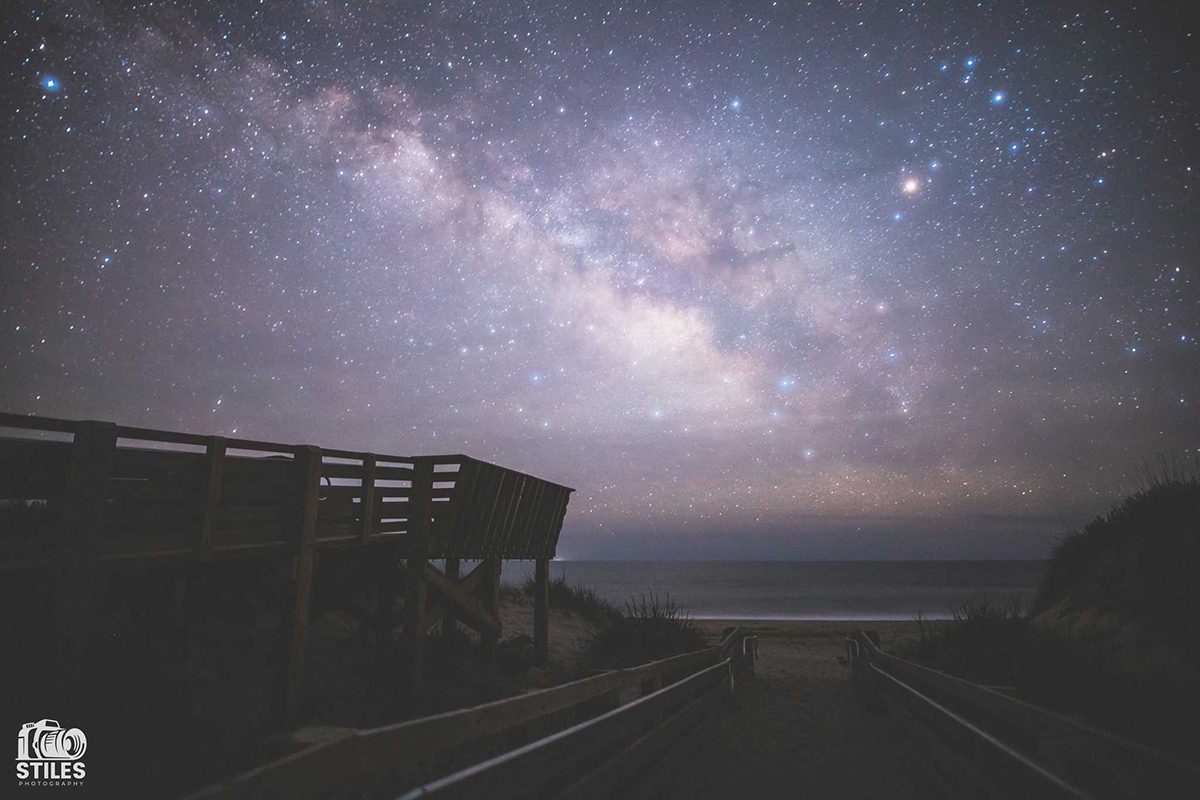
Reprinted from the Ocracoke Observer
One can feel helpless at times as to what one can do in the face of large-scale environmental catastrophes such as the unfathomable amount of plastic in the ocean. But individuals can take some actions that can make a positive difference and keeping the night as dark as possible is one of them.
Supporter Spotlight
Kaye and Rick Kohler are longtime vacation visitors to Ocracoke, during their visit in June they discussed their efforts in a talk in the Ocracoke Community Library: “Dark Skies: How to Preserve and Protect One of the Island’s Natural Wonders.” Rick also was a guest on WOVV’s “What’s Happening on Ocracoke.”
The Kohlers live in Rappahannock County by the Blue Ridge Mountains and Shenandoah National Park in Virginia.

As longtime members of the Rappahannock League for Environmental Protection, they have been concerned with the harmful effects of artificial lighting on the health of people and wildlife.
In 2019, the League, working with others, was successful in getting the Rappahannock community park certified as a Silver-Tier Dark Skies Park by the DarkSky International (IDA).
The IDA’s mission is to raise awareness about the negative effects of artificial light at night on human health, wildlife, and to provide the public with information and resources to help restore the night.
Supporter Spotlight
They have their work cut out as every year light pollution is increasing by about 10 percent around the USA, Rick said in his talk.
Rick and Kaye’s talk focused on what the IDA says, there is overwhelming evidence that light pollution can have harmful impacts on both people and wildlife and they provided examples.
Like many animals, humans have biological clocks called circadian rhythms regulated by the natural light-dark cycle.
Artificial lighting can disrupt these rhythms, which can cause insomnia, eye strain, headaches and lead to stress, anxiety and depression.
Artificial light can harm animals and even plants.
Nocturnal frogs and toads rely on darkness to make their mating calls. Excessive lighting can adversely impact their reproduction rates.
During nocturnal migration, birds become disoriented by bright lights causing millions of deaths every year by fatal collisions with tall lit buildings, some with reflective glass walls.
Last October, more than 1,000 birds were killed striking just one lit building in Chicago which lies along a major migratory route.
Fireflies are facing a worldwide decreasing population. Their flash of light is their mating signal and without darkness, they cannot find mates.
Some plants rely on specific lengths of daylight to trigger flowering and artificial lighting can cause them to grow more rapidly, flower out of season or not at all. Light pollution can disrupt the behavior of nocturnal pollinators like moths. One study showed that moths flew toward the street lamps and away from flowering plants. This resulted in a reduction of plant pollination.
Artificial lighting can cause sea turtle hatchlings to become disoriented and wander inland, where they often die of dehydration or predation by ghost crabs, raccoons, opossums and coyotes, according to the Sea Turtle Conservancy.
Its website notes scientists believe the hatchlings have an innate instinct that leads them to the brightest horizon, which, historically meant over the ocean.
The Cape Hatteras National Seashore provides information on how artificial light is harmful to hatchlings and what steps can be taken to reduce lighting.
Coastal communities around the world have passed ordinances that require residents to turn off beachfront lights during turtle nesting season, but not everyone complies.
In the upper Outer Banks, when sea turtles are getting ready to hatch, physical barriers, like screens or shades, are put up to block light from reaching the beach.
Ocracoke village is surrounded by dark skies, which makes stargazing and astronomy an attraction.
But Ocracoke village has grown brighter in the last several years, creating what is known as a sky glow that reduces the ability to see the stars at night.
The Kohlers say a lot of this diffused light can be remedied by using down-shielded light fixtures that direct the light downward where it is needed and does not allow the light to go upward.
Other steps include using warm-colored LED bulbs with a color temperature of 3000K or lower. These bulbs emit less blue light, which is more likely to scatter in the atmosphere.
Smart lighting systems, motion sensors and timers ensure that lights are only on when necessary, thereby reducing overall light output.

In 2021, Cape Lookout National Seashore became an International Dark Sky Park designated by the IDA. It joined 121 other national parks and is the first to receive this certification on the Atlantic Coast. This was achieved by community support from the Crystal Coast Stargazers Club, the Core Sound Waterfowl Museum and Heritage Center and the Carteret County Chamber of Commerce.
Cape Hatteras National Seashore has completed some steps in the process, but an official application has not been submitted, according to Mike Barber, the public affairs specialist.
Unlike the challenge of combatting human-caused climate change, reducing light pollution is as easy as simply leaving lights off at night whenever possible and by directing outside lighting downward.
So, comparatively, drastically reducing one of our many forms of pollution is as easy as, well, the flick of a light switch.
Also from the Ocracoke Observer: Let’s get Cape Hatteras National Seashore designated as an International Dark Sky Park
This story is provided courtesy of the Ocracoke Observer, a newspaper covering Ocracoke island. Coastal Review Online partners with the Ocracoke Observer to provide readers with more environmental and lifestyle stories of interest along our coast.








